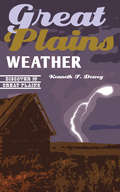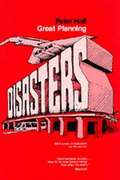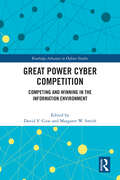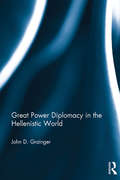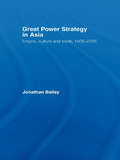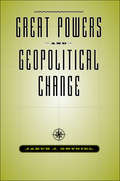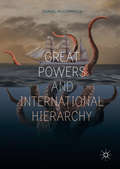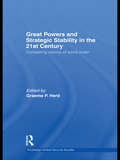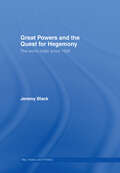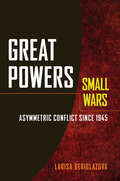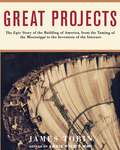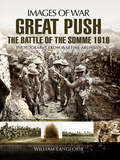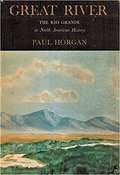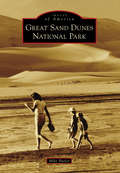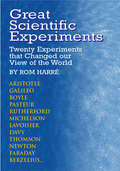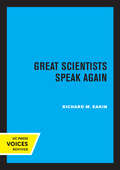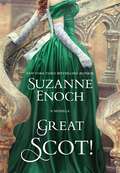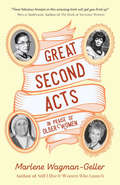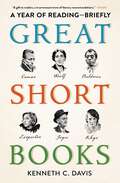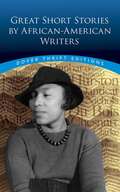- Table View
- List View
Great Plains Weather (Discover the Great Plains)
by Kenneth F. DeweyThe weather of the Great Plains is extreme and highly variable, from floods to droughts, blizzards to tornadoes. In Great Plains Weather Kenneth F. Dewey explains what makes this region’s climate unique by presenting a historical climatology of extreme weather events. Beginning with tornadoes—perhaps the most formidable plains weather phenomena—he describes the climatology of these storms and discusses memorable tornadoes of the plains. As one of the storm chasers who travels the Great Plains in the spring and summer tracking severe weather, Dewey also shares some of his experiences on the road. Dewey then goes on to discuss famous blizzards, from the “School Children’s Storm” of 1888 to more recent storms, along with droughts and floods. Precipitation, or the lack thereof, has long determined human activity in the region; exacerbated by the vagaries of climate change, it continues to have a significant economic and cultural impact on the people of the plains. Dewey’s absorbing narrative is complemented by images of tornadoes, snowstorms, and flash floods that he amassed in forty years of climatological research.
Great Planning Disasters
by Peter HallRecounts the histories of five great planning disasters and two near-disasters and analyzes the decisions of the professional bureaucrats, community activists, and politicians involved in the planning process.
Great Power Cyber Competition: Competing and Winning in the Information Environment (Routledge Advances in Defence Studies)
by David V. Gioe Margaret W. SmithThis volume conceptualizes the threats, challenges, opportunities, and boundaries of great power cyber competition of the 21st century. This book focuses on a key dimension of contemporary great power competition that is often less understood due to its intangible character: the competition taking place in the cyber domain, including information and cyber operations. Democracies across the globe find themselves in an unrelenting competition with peer and near-peer competitors, with a prevailing notion that no state is "safe" from the informational contest. Adversarial powers, particularly China and Russia, recognize that most competition is principally non-kinetic but dominates the information environment and cyberspace, and the volume articulates the Russian and Chinese strategies to elevate cyber and information competition to a central position. Western governments and, in particular, the U.S. government have long conceived of a war–peace duality, but that perspective is giving way to a more nuanced perception of competition. This volume goes beyond analyzing the problems prevalent in the information space and offers a roadmap for Western powers to compete in and protect the global information environment from malicious actors. Its genesis is rooted in the proposition that it is time for the West to push back against aggression and that it needs a relevant framework and tools to do so. The book demonstrates that Western democratic states currently lack both the strategic and intellectual acumen to compete and win in the information and cyber domains, and argues that the West needs a strategy to compete with near-peer powers in information and cyber warfare. This book will be of much interest to students of cyber-warfare, information warfare, defense studies, and international relations in general, as well as practitioners.
Great Power Diplomacy in the Hellenistic World
by John D GraingerDiplomacy is a neglected aspect of Hellenistic history, despite the fact that war and peace were the major preoccupations of the rulers of the kingdoms of the time. It becomes clear that it is possible to discern a set of accepted practices which were generally followed by the kings from the time of Alexander to the approach of Rome. The republican states were less bound by such practices, and this applies above all to Rome and Carthage. By concentrating on diplomatic institutions and processes, therefore, it is possible to gain a new insight into the relations between the kingdoms. This study investigates the making and duration of peace treaties, the purpose of so-called 'marriage alliances', the absence of summit meetings, and looks in detail at the relations between states from a diplomatic point of view, rather than only in terms of the wars they fought. The system which had emerged as a result of the personal relationships between Alexander's successors, continued in operation for at least two centuries. The intervention of Rome brought in a new great power which had no similar tradition, and the Hellenistic system crumbled therefore under Roman pressure.
Great Power Discord in Palestine: The Anglo-American Committee of Inquiry into the Problems of European Jewry and Palestine 1945-46
by Amikam NachmaniA reconstruction of the proceedings of the "Anglo-American Committee of Inquiry into the problems of European Jewry and Palestine, 1945 to 1946". This study places the inquiry within the wider context of Anglo-American relations in the Middle East.
Great Power Strategy in Asia: Empire, Culture and Trade, 1905-2005
by Jonathan BaileyGreat Power Strategy in Asia, 1905-2005 analyzes the enduring themes underlying the strategic struggles in East Asia, beginning with the crucial event of the 1904-5 Russo-Japanese War. Jonathan Bailey clearly shows why military history is highly relevant in understanding today’s strategic problems, and how the most important areas of current affairs have their roots in often forgotten corners of military history. He makes his powerful case in three clear sections: an analysis of the explosive factors that led to war between Russia and Japan in 1904, presenting a ten-year perspective of the War, focusing on its consequences: cultural shock in ‘the West’, re-alignment of Asian imperial geography and the failure to learn vital military lessons, as World War I approached a thirty-five year perspective of the war, showing why Japan repeated the essential strategic, operational and tactical ploys of its war against Russia in 1904 in its strike upon the USA in 1941. Allied victory assured the downfall of Europe’s empires in Asia, with the USA inheriting much of the old imperial legacy a centennial view of the Russo-Japanese War, which demonstrates that many of the broader issues identifiable in 1904-05 remain at the heart of today’s strategic discourse: Western apprehension about the economic rise of Japan; the anomalies of an ‘American Empire’; tensions between Occident and Orient; the apparent new relevance of geopolitics; and the importance of demography in perceptions of global power. This book is multidisciplinary, emphasizing the linkages between imperial power-politics, military operations, cultural conflict and commercial rivalry. It is also the story of military innovation, the pathology of learning lessons from the experience of war, and the anticipated rise of Asian, or more specifically Chinese, power a century after the false dawn of the Japanese victory in 1905. This book will be of great interest to all students of the Russo-Japanese War, Asian security, and of military and strategic studies.
Great Powers and Geopolitical Change
by Jakub J. GrygielNamed by Foreign Affairs as a book to read on geopolitics.In an era of high technology and instant communication, the role of geography in the formation of strategy and politics in international relations can be undervalued. But the mountains of Afghanistan and the scorching sand storms of Iraq have provided stark reminders that geographical realities continue to have a profound impact on the success of military campaigns. Here, political scientist Jakub J. Grygiel brings to light the importance of incorporating geography into grand strategy. He argues that states can increase and maintain their position of power by pursuing a geostrategy that focuses on control of resources and lines of communication.Grygiel examines case studies of Venice, the Ottoman Empire, and China in the global fifteenth century—all great powers that faced a dramatic change in geopolitics when new routes and continents were discovered. The location of resources, the layout of trade networks, and the stability of state boundaries played a large role in the success or failure of these three powers. Grygiel asserts that, though many other aspects of foreign policy have changed throughout history, strategic response to geographical features remains one of the most salient factors in establishing and maintaining power in the international arena.
Great Powers and International Hierarchy
by Daniel McCormackHierarchical relationships—rules that structure both international and domestic politics—are pervasive. Yet we know little about how these relationships are constructed, maintained, and dismantled. This book fills this lacuna through a two-pronged research approach: first, it discusses how great power negotiations over international political settlements both respond to domestic politics within weak states and structure the specific forms that hierarchy takes. Second, it deduces three sets of hypotheses about hierarchy maintenance, construction, and collapse during the post-war era. By offering a coherent theoretical model of hierarchical politics within weaker states, the author is able to answer a number of important questions, including: Why does the United States often ally with autocratic states even though its most enduring relationships are with democracies? Why do autocratic hierarchical relationships require interstate coercion? Why do some hierarchies end violently and others peacefully? Why does hierarchical competition sometimes lead to interstate conflict and sometimes to civil conflict?
Great Powers and Strategic Stability in the 21st Century: Competing Visions of World Order (Routledge Global Security Studies)
by Graeme P. HerdThis book addresses the issue of grand strategic stability in the 21st century, and examines the role of the key centres of global power - US, EU, Russia, China and India - in managing contemporary strategic threats. This edited volume examines the cooperative and conflictual capacity of Great Powers to manage increasingly interconnected strategic threats (not least, terrorism and political extremism, WMD proliferation, fragile states, regional crises and conflict and the energy-climate nexus) in the 21st century. The contributors question whether global order will increasingly be characterised by a predictable interdependent one-world system, as strategic threats create interest-based incentives and functional benefits. The work moves on to argue that the operational concept of world order is a Concert of Great Powers directing a new institutional order, norms and regimes whose combination is strategic-threat specific, regionally sensitive, loosely organised, and inclusive of major states (not least Brazil, Turkey, South Africa and Indonesia). Leadership can be singular, collective or coalition-based and this will characterise the nature of strategic stability and world order in the 21st century. This book will be of much interest to students of international security, grand strategy, foreign policy and IR. Graeme P. Herd is Co-Director of the International Training Course in Security Policy at the Geneva Centre for Security Policy (GCSP). He is co-author of several books and co-editor of The Ideological War on Terror: World Wide Strategies for Counter Terrorism (2007), Soft Security Threats and European Security (2005), Security Dynamics of the former Soviet Bloc (2003) and Russia and the Regions: Strength through Weakness (2003).
Great Powers and the Quest for Hegemony: The World Order since 1500 (War, History And Politics Ser.)
by Jeremy BlackThis timely book provides a general overview of Great Power politics and world order from 1500 to the present. Jeremy Black provides several historical case-studies, each of which throws light on both the power in question and the international system of the period, and how it had developed from the preceding period. The point of departure for this
Great Powers, Small Wars: Asymmetric Conflict since 1945
by Larisa DeriglazovaA sophisticated appraisal of the problem of asymmetric conflict in the post–World War II period.In a sophisticated combination of quantitative research and two in-depth case studies, Larisa Deriglazova surveys armed conflicts post World War II in which one power is much stronger than the other. She then focuses on the experiences of British decolonization after World War II and the United States in the 2003 Iraq war. Great Powers, Small Wars employs several large databases to identify basic characteristics and variables of wars between enemies of disproportionate power. Case studies examine the economics, domestic politics, and international factors that ultimately shaped military events more than military capacity and strategy.
Great Powers, Weak States, and Insurgency
by Patrick W. QuirkThis book offers an original and theoretically rich examination into the dynamics of alliances that great powers and weak states form to defeat threats, such as rebellion or insurgency, within the smaller state's borders. The author examines contemporary examples of such "internal threat alliances," including Russia's collaboration with Syria's Assad regime to defeat anti-government rebels and U. S. cooperation with Afghanistan's ruling political elite to combat the Taliban. In each case, the weaker state's leadership wanted to remain in power while the great power sought to safeguard its interests linked to the regime's stability. The book adds to International Relations (IR) theory by presenting a distinct conceptual framework that explains why internal threat alliances form, why some are more cohesive than others, and why some are effective while others are not. It thus promises to be of interest to IR scholars and students working in the areas of security studies, alliance dynamics, political violence, and civil war, but also to policy-makers grappling with how to salvage interests, such as access to natural resources or regional stability, imperiled by violence in weak states.
Great Pretenders
by Karen SchoemerFebruary 1964: The Beatles step onto the tarmac at JFK International Airport and turn the country on its head. It's the advent of rock and roll's uninterrupted reign, youthful rebellion, and overt teenage sex. It's also the deathblow for the pop music of another generation -- the songs of Pat Boone and Georgia Gibbs -- and all its perky, white-bread conformity. Not two years later, Karen Schoemer is born, and comes of age with rock and roll. While her parents might enjoy the new music, the cultural upheaval passes them by, and they cling to the promises made by the music they loved as teenagers, the sweet, innocent 1950s pop of Patti Page, Frankie Laine, and the like. But having courted and wed against a backdrop of ideals peddled by this music -- finding true love, living happily ever after -- Schoemer's parents, like so many people, are crushed by disappointment when love doesn't deliver what the songs promised. Fifties pop falls quickly off the charts; their marriage eventually falls apart. In Great Pretenders, a lively, provocative blend of memoir and music criticism, former Newsweek pop music critic Karen Schoemer tries to figure out what went so wrong, way back in the hazy past, for her parents' marriage and for the music of their youth. To find the answers, she embarks on a strange, lonely journey in search of some of the brightest stars of the 1950s. Schoemer's search started when, twenty years after her parents' divorce, the new Connie Francis box set appeared on her desk at Newsweek. Now a successful rock critic dispensing post-punk opinions to the hipoisie, she was about to toss aside this relic when she was struck by the cover image of Francis, which bore an uncanny resemblance to her own mother; on a whim, she played one of the CDs. For all their cloying, simplistic sentimentality, songs like "Where the Boys Are" had an undeniable power -- "the sound of every teenage girl in every bedroom on every lonely Saturday going back a thousand years." It was the music of her parents' long-lost adolescence, and much to her surprise, it moved her. Thus Schoemer, arbiter of Gen X cool, found herself falling into the saccharine thrall of 1950s pop music, that pariah of the rock establishment. Even as her colleagues tried to steer her away from the terminally uncool genre, she tracked down seven former pop idols of the late 1950s and early 1960s: Connie Francis, Fabian, Pat Boone, Patti Page, Tommy Sands, Georgia Gibbs, and Frankie Laine. As she became privy to their inner lives and immersed herself in their music, Schoemer revised her own notions about the fifties at the same time that she explored her family's vexed dynamic. The result is a wonderful romp through an unappreciated chapter in music history and, more important, through her own past. Full of humor, insight, and unflinching honesty, Great Pretenders bucks the received wisdom, explores the intersections of our private lives and pop culture, and broadens our understanding of a crucial moment in our history.
Great Projects: The Epic Story of the Building of America, from the Taming of the Mississippi to the Invention of the Internet
by James TobinSince the earliest days of the republic, great engineering projects have shaped American landscapes and expressed American dreams. The ambition to build lies as close to the nation's heart as the belief in liberty. We live in a built civilization, connected one to another in an enormous web of technology. Yet we have all too often overlooked the role of engineers and builders in American history. With glorious photographs and epic narrative sweep, Great Projects at last gives their story the prominence it deserves.Each of the eight projects featured in this masterful narrative was a milestone in its own right: the flood-control works of the lower Mississippi, Hoover Dam, Edison's lighting system, the spread of electricity across the nation, the great Croton Aqueduct, the bridges of New York City, Boston's revamped street system, known as the Big Dig, and the ever-evolving communica- tions network called the Internet. Each project arose from a heroic vision. Each encountered obstacles. Each reveals a tale of genius and perseverance.James Tobin, winner of a National Book Critics Circle Award, explains the four essential tasks of the engineer: to protect people from the destructive force of water while harnessing it for the enormous good it can do; to provide people with electricity, the motive force of modern life; to make great cities habitable and vital; and to create the pathways that connect place to place and person to person. Tobin focuses on the indi- viduals behind our greatest structures of earth and concrete and steel: James Buchanan Eads, who walked on the floor of the Mississippi to learn the river's secrets; Arthur Powell Davis and Frank Crowe, who imagined a dam that could transform the West; Thomas Edison, who envisioned a new way to light the world; Samuel Insull, the organizational mastermind of the electrical revolution; the long-forgotten John Bloomfield Jervis, who assured New York's future with the gift of clean water; Othmar Ammann, the modest Swiss-American who fought his mentor to become the first engineer to bridge the lower Hudson River; Fred Salvucci, the antihighway rebel who transformed the face of Boston; and J.C.R. Licklider, the obscure scientist who first imagined the Internet. Here, too, are the workers who scorned hardship to turn the engineers' dreams into reality, deep underground and high in the sky, through cold and heat and danger. In Great Projects -- soon to be a major PBS television series by the Emmy Award-winning Great Projects Film Company -- we share their dreams and witness their struggles; we watch them create the modern world we walk through each day -- the "city upon a hill" that became our America.
Great Push: The Battle of the Somme, 1916 (Images of War)
by William LangfordIn 1916, Sir Douglas Haig, commanding the BEF, began his great offensive to drive the invaders off the ground they had been occupying for over a year and a half. The Great Push, as the offensive was advertised to the nation, began 1 July 1916. A glossy picture magazine was produced to inform the British public of the progress of the offensive. Over a four month period until the Battle of the Somme faded away in November the magazine appeared with the following advertising blurb:Sir Douglas Haigs Great Push; The Battle of the Somme; A popular, pictorial and authoritative work on one of the Greatest Battles in History, illustrated by about 700 wonderful Official Photographs and Cinematograph Films; By Arrangement With the War Office; beautifully printed on the Best English Art Paper. As is well known, the Great Push turned out to be little more than a nudge, but, for the sake of national morale, the British public had to be encouraged to believe that all was going well; especially in view of the horrific casualties wrecking the lives of families throughout the land.The Great Push, in the form of Images of War, helps capture the propaganda thrust of the times and presents once more the illustrations of those bewildering days.
Great River: The Rio Grande in North American History
by Paul HorganWith the skill of a novelist, and the love of a long-time resident, Paul Horgan describes the Rio Grande, its role in human history, and the overlapping cultures that have grown up alongside it or entered into conflict over the land it traverses.<P><P> Pulitzer Prize Winner
Great River: The Rio Grande in North American History. Vol. 1, Indians and Spain. Vol. 2, Mexico and the United States. 2 vols. in one (Texas Classics Ser.)
by Paul. HorganWinner of both the Pulitzer Prize and Bancroft Prize for History, Great River was hailed as a literary masterpiece and enduring classic when it first appeared in 1954. It is an epic history of four civilizations--Native American, Spanish, Mexican, and Anglo-American--that people the Southwest through ten centuries. With the skill of a novelist, the veracity of a scholar, and the love of a long-time resident, Paul Horgan describes the Rio Grande, its role in human history, and the overlapping cultures that have grown up alongside it or entered into conflict over the land it traverses. Now in its fourth revised edition, Great River remains a monumental part of American historical writing.
Great Sand Dunes National Park
by Mike ButlerSouthern Colorado's unique Great Sand Dunes rise to a height of 750 feet above the San Luis Valley floor and are the nation's highest dunes not adjacent to an ocean or lake. The sweeping dunes were protected as a national monument in 1932 and as a national park in 2000. From prehistoric hunter-gatherers to the historic Ute Indian tribe, inhabitants have long used the resources of the land around the dunes. Zebulon Pike was the first American explorer to witness the dunes in 1807, followed by a long procession of other explorers, ranchers, and miners. Today, visitors from around the world come to climb up and slide down the dunes in Great Sand Dunes National Park and Preserve.
Great Scientific Experiments: Twenty Experiments that Changed our View of the World
by Rom HarreThese vividly recounted tales of human skill and ingenuity offer fascinating views of the correlation between theories, practical inquiries, ideas, and facts. Re-created strictly on the basis of the original publication in which the results were first announced, the scrupulously accurate retellings of 20 groundbreaking scientific experiments are complemented with rare photos and illustrations.Based on such criteria as fame, historical importance, elegance, and economy of method, the experiments include Aristotle's work on the embryology of the chick, Galileo's discovery of the law of descent, Newton's experiment on the nature of colors, Lavoisier's proof of the oxygen hypothesis, William Beaumont's work on the process of digestion, Faraday's demonstration of the identity of all forms of electricity, J. J. Thompson's discovery of the electron, Michelson and Morely's demonstration of the impossibility of detecting the motion of the earth, and a dozen others.Each experiment is appraised and analyzed in the light of subsequent developments, placing the work within the context of the history of science. In addition to diagrams and photographs of the experimental method and apparatus, brief biographies and portraits of the scientist appear as well.Rom Harré is a Fellow Emeritus of Linacre College, Oxford, and an Adjunct Professor at Georgetown University and American University, Washington, D.C.
Great Scientists Speak Again
by Richard M. EakinThe author writes of this book: "'What lead you to impersonate great biologists?' is a question often asked of me. My answer varies depending upon the interviewer. Sometimes I cite my interest in biographies of distinguished scientists initiated by a reading of Vallery-Radot's The Life of Pasteur as a teenage and furthered by a superb college course on the history of biology. Another answer: my love of the theater, more from the balcony than on the stage as a ham actor. My most frequent reply, however, credits this instructional innovation to the students in my Berkeley course in general biology (Zoology 10), who began to show, in the late sixties, their dissatisfaction with the lecture system. "I gave serious thought to the problem of communicating biological information with greater impact. One morning in the shower I was stuck not only by the spray but also by an idea: dress up and make up as some of the great biologists and present their discoveries and thoughts in their own words. In addition to expounding their scientific work, portray them as persons with hopes and ambitions, frustration over failure, and joy from success. I chose Darwin, Mendel, Harvey, and Pasteur, who would probably be on the most lists of great biologists, and two lesser-known scientists: William Beaumont, pre-Civil War Army surgeon who studied gastic digestion in the stomach of a fur-trapper, Alexis St. Martin; and Hans Spemann, 1935 Nobel Laureate in Physiology and Medicine, who discovered the organizer principle in embryonic development. The results of the innovation, which I call guest lecturers, were gratifying. "Late five of the lectures, in abbreviated form, were recorded on motion picture film (available through the Media Center of the University of California, Berkeley). Then it was suggested that a much wider audience should be reached through publication of the lectures in book form, illustrated with photographs of the 'guest lecturers' in action and with drawings, charts, maps, and reproductions of lantern slides." This title is part of UC Press's Voices Revived program, which commemorates University of California Press's mission to seek out and cultivate the brightest minds and give them voice, reach, and impact. Drawing on a backlist dating to 1893, Voices Revived makes high-quality, peer-reviewed scholarship accessible once again using print-on-demand technology. This title was originally published in 1975.
Great Scot!
by Suzanne EnochPreviously published in the anthology Kissing Under the Mistletoe, New York Times bestselling author Suzanne Enoch returns to the Scottish highlands to bring the delightful and steamy Christmas historical romance novella Great Scot!Miss Jane Bansil knows she will never have a fairy-tale moment. Well past the marriageable age, she’s taken a position as a companion and is now stuck in Scotland for Christmas, alone even in the middle of the boisterous MacTaggert family. But when Brennan Andrews, an architect and cousin to the MacTaggerts, arrives to draw up plans for a new family home, Jane must decide if she will take a chance at a happily-ever-after, or settle into her small, safe life for good.
Great Second Acts: In Praise of Older Women (Celebrating Women Ser.)
by Marlene Wagman-GellerThese inspiring true stories of women who&’ve made the most of their mature years &“will get you fired up&” (Becca Anderson, author of The Book of Awesome Women and Real Life Mindfulness). The amazing women profiled in Great Second Acts refused to be defined by the dates on their birth certificates. Their lives are testimony that one can be feisty after fifty—and this book says in no uncertain terms to those who think otherwise, in the words of Justice Ruth Bader Ginsburg: &“I dissent.&” This isa fascinating collection of biographical sketches of dozens of women of a certain age who have excelled, inspired, and achieved. Learn how these women changed their respective fields of art, politics, science, mathematics, media, literature, business, activism, education, and more. Included are:· Biographies of influential women such as PM Margaret Thatcher, chef Julia Child, Mother Teresa, feminist Gloria Steinem, actress Rita Moreno, inventor Ruth Handler, Judge Judy Sheindlin, and many more· Empowering quotes from strong women who epitomize grit and persistence · Motivational, inspirational, and educational stories of ordinary older women who&’ve accomplished extraordinary things
Great Short Books: A Year of Reading—Briefly (Great Short Books)
by Kenneth C. DavisThis entertaining guide to some of the best short novels of all time, from a bestselling historian, is the &“perfect gift for busy bibliophiles&” (BookPage).Experience the joys of literature with this this &“exciting guide to all that the world of fiction has to offer&” (The New York Times Book Review): a compulsively readable, deeply engaging discussion of great short novels. A journey into fiction designed with our contemporary attention spans in mind, Great Short Books suggests fifty-eight excellent short novels, all under 200 pages—easily readable in a week or less—a fresh approach to a fun, fascinating year of reading. From hard-boiled fiction to magical realism, the 18th century to the present day, Great Short Books spans genres, cultures, countries, and time to present an enchanting and diverse selection of acclaimed and canonical novels. From works in translation like Yu Miri&’s Tokyo Ueno Station and Marguerite Duras&’s The Lover to popular, acclaimed authors like Toni Morrison and James Baldwin, this compilation is a celebration of classics from the historic to contemporary—plus a few bestsellers, including Stephen King and Colson Whitehead. Each entry includes the novel&’s opening lines, a spoiler-free plot summary, a &“why you should read it&” section, and suggestions for what to read next. &“An entertaining journey with a fun, knowledgeable guide&” (Booklist), this eclectic collection is a fun and practical book for any passionate reader hoping to broaden their literary IQ—or anyone who wants to find an effortless reentry into reading.
Great Short Stories by African-American Writers (Dover Thrift Editions)
by Bob Blaisdell Christine Rudisel<p>Offering diverse perspectives on the black experience, this anthology of short fiction spotlights works by influential African-American authors. Nearly 30 outstanding stories include tales by W. E. B. Du Bois, Zora Neale Hurston, Claude McKay, and Jamaica Kincaid. <p>From the turn of the twentieth century come Alice Ruth Moore's "A Carnival Jangle," Charles W. Chesnutt's "Uncle Wellington’s Wives," and Paul Laurence Dunbar's "The Scapegoat." Other stories include "Becky" by Jean Toomer; "Afternoon" by Ralph Ellison; Langston Hughes's "Feet Live Their Own Life"; and "Jesus Christ in Texas" by W. E. B. Du Bois. Samples of more recent fiction include tales by Jervey Tervalon, Alice Walker, and Edwidge Danticat. Ideal for browsing, this collection is also suitable for courses in African-American studies and American literature.</p>
Great Sky Woman
by Steven BarnesAn acclaimed author of science fiction and alternate history takes readers to the foot of Mount Kilimanjaro and into the realm of primitive humans, who lived, hunted, celebrated, and died side by side with roaming herds of wild animals.
